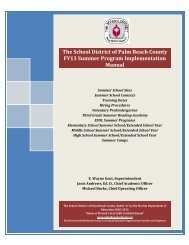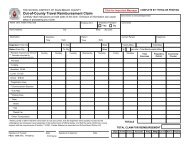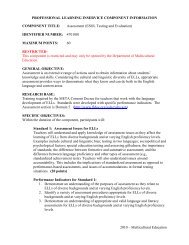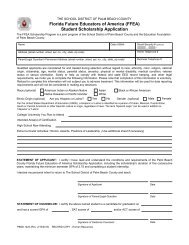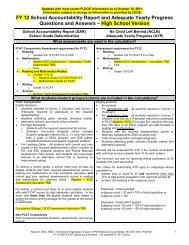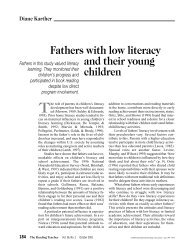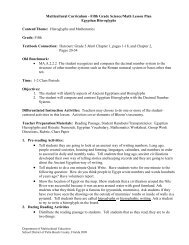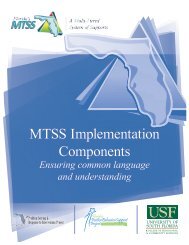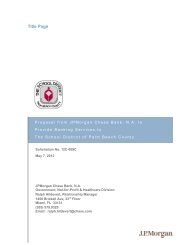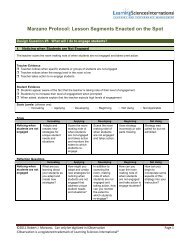English/Language Arts - The School District of Palm Beach County
English/Language Arts - The School District of Palm Beach County
English/Language Arts - The School District of Palm Beach County
You also want an ePaper? Increase the reach of your titles
YUMPU automatically turns print PDFs into web optimized ePapers that Google loves.
<strong>School</strong> <strong>District</strong> <strong>of</strong> <strong>Palm</strong> <strong>Beach</strong> <strong>County</strong><br />
Department <strong>of</strong> K-12 Curriculum<br />
Winter Break Reading & <strong>English</strong>/<strong>Language</strong> <strong>Arts</strong><br />
High <strong>School</strong> Student Packet
<strong>School</strong> <strong>District</strong> <strong>of</strong> <strong>Palm</strong> <strong>Beach</strong> <strong>County</strong> Department <strong>of</strong> K-12 Curriculum<br />
Winter Break Reading & <strong>English</strong>/<strong>Language</strong> <strong>Arts</strong> Student Packet<br />
Guidelines:<br />
Middle & High <strong>School</strong> <strong>English</strong>/<strong>Language</strong> <strong>Arts</strong> teachers will distribute the Winter<br />
Break Reading & <strong>English</strong>/<strong>Language</strong> <strong>Arts</strong> student packet to all students prior to the<br />
break. Students are to complete this packet with the following recommendations:<br />
Grades 10 through retakes will complete the writing portion <strong>of</strong> the packet,<br />
in addition to completing the reading passages and multiple choice<br />
questions.<br />
Students in Grades 10 through retakes will receive the Essay Organizer<br />
handout to assist them in practicing effective writing skills when completing<br />
the writing prompt.<br />
<strong>English</strong>/<strong>Language</strong> <strong>Arts</strong> teachers will collect these packets from all students after<br />
the Winter Break.<br />
<strong>The</strong> <strong>English</strong>/<strong>Language</strong> <strong>Arts</strong> teachers will review the reading (Grades<br />
10‐retakes) and writing portions (Grades 10 through retakes) <strong>of</strong> the packets<br />
with students.<br />
<strong>The</strong> Reading teachers will also review and reinforce the reading portions <strong>of</strong><br />
the packets with students.<br />
For further questions or support contact the Department <strong>of</strong> K-12 Curriculum:<br />
Liz Perlman, Director<br />
561-434-8255<br />
PX 48255<br />
liz.perlman@palmbeachschools.org
Suggestions for Completing the High <strong>School</strong><br />
Winter Break Packet<br />
<strong>The</strong> High <strong>School</strong> Winter Break Packet has reading passages followed by<br />
multiple-choice questions.<br />
Read the directions carefully. Ask your parents or guardians to help you<br />
understand any directions you do not understand.<br />
Read the passages and questions carefully. You may look back at a<br />
passage as <strong>of</strong>ten as you like.<br />
Use highlighters or pencils to underline important information as you<br />
read.<br />
Answer the questions you are sure about first. If a question seems too<br />
difficult, skip it and go back to it later.<br />
Think positively. Some questions may seem hard, but others will be easy.<br />
Check each answer to make sure it is the best answer for the question.<br />
Complete the figurative language chart which asks you to create<br />
figurative language following the example. Share your responses with a<br />
parent or guardian.<br />
Write a well constructed essay using the prompt provided. Be sure to<br />
include some figurative language in your essay.<br />
Read your essay aloud and make any corrections you think would<br />
improve your writing.
Directions: Read the article Survival Acts, and then answer questions 1- 11.<br />
Survival Acts<br />
Freezing solid. Playing dead. Walking on water. Explore these amazing animal survival<br />
acts.<br />
By Lynn Brunelle<br />
Near the Arctic Circle, a small wood frog digs into a pile <strong>of</strong> damp leaves. Winter is coming and it<br />
has no time to waste. Already, it's so cold out that the frog's toes have started to freeze. <strong>The</strong><br />
frog pulls the leaves over itself like a blanket. <strong>The</strong>n it waits. It doesn't move. It doesn't eat.<br />
Outside, the air temperature keeps dropping. Soon it's way below freezing. <strong>The</strong> bitter cold<br />
spreads into the leaf pile. <strong>The</strong> frog's muscles freeze. Ice builds up around its liver, lungs, and<br />
other organs. Its heartbeat slows. <strong>The</strong>n the frog takes a final breath. Its heart stops.<br />
For most animals, that would be the end. Not for this frog. It freezes to survive. Only a few<br />
species <strong>of</strong> frogs, turtles, and insects do that.<br />
Deep Freeze<br />
Turning into a "frogsicle" isn't just an odd trick. <strong>The</strong> frog's actions are a behavioral adaptation. A<br />
behavioral adaptation is something an animal does to survive in its environment.<br />
For instance, when the weather turns cold, many birds migrate. <strong>The</strong>y fly to warm places for the<br />
winter. Many bears curl up in snug dens for the coldest months <strong>of</strong> the year. <strong>The</strong>y hibernate, or<br />
become inactive and mostly rest.<br />
A wood frog takes hibernation to extremes. Its instinct to hibernate kicks in as soon as its toes<br />
start to freeze. Inside its body, its liver starts making extra glucose. Its blood<br />
carries this sugar to the frog's cells.<br />
<strong>The</strong> glucose acts as antifreeze. It keeps water inside the cells from freezing.<br />
Freezing could damage the cells and kill the frog.<br />
<strong>The</strong> rest <strong>of</strong> the water in the frog's body does freeze. It turns the frog into an<br />
ice cube.<br />
Wood Frog: On<br />
Mushroom
<strong>The</strong> frog will remain mostly frozen for two or three months. During this time, it won't need to<br />
spend energy to stay warm. It won't need to find food or water. It won't look like it's alive at all.<br />
A wood frog can survive like this as long as the temperature in its leaf pile doesn't go too low. If<br />
the temperature dips below -6° Celsius (about 21° Fahrenheit), the frog will die.<br />
It's Alive!<br />
When spring comes, something amazing happens. <strong>The</strong> frog's heart beats once. <strong>The</strong>n it beats<br />
again. Slowly, blood pumps through the frog's body. <strong>The</strong> rest <strong>of</strong> its body begins to thaw.<br />
Its brain, lungs, and other organs warm up. Finally, its toes unfreeze. <strong>The</strong> frog wiggles them. It<br />
pops its head out <strong>of</strong> its leaf pile. "Quack, quack," it croaks, calling out to other thawed frogs.<br />
<strong>The</strong>n it hops away.<br />
<strong>The</strong> frozen frog isn't the only animal that goes to extremes to survive. Many other species do,<br />
too. Some have wild ways to escape danger. Others take parenting to a whole new level. Meet<br />
some other animals and discover their amazing behavioral adaptations.<br />
Playing Dead<br />
A European grass snake slithers across the ground. It's on the hunt for a tasty toad. Yet it must<br />
be careful. Hawks, badgers, and other animals prey on the snake.<br />
Suddenly, the snake spots danger. It's a badger and it's about to pounce.<br />
<strong>The</strong> snake goes into action. It raises its head and strikes at the badger. It looks as if it is about<br />
to bite. <strong>The</strong> badger doesn't back <strong>of</strong>f. Instead, it grabs the snake in its mouth.<br />
<strong>The</strong> snake isn't done fighting back, though. It goes limp. Its mouth flops open and its tongue<br />
hangs out. It makes a foul smell and oozes goo.<br />
<strong>The</strong> startled badger spits the snake out. <strong>The</strong> snake flops to the<br />
ground. It looks dead. What's worse, it smells dead. As soon as<br />
the badger looks away, though, the snake flips over. It quickly<br />
slithers to safety. Its behavioral adaptation <strong>of</strong> playing dead saved<br />
its life.<br />
Eastern Hognose Snake: Feigning Death<br />
Walking on Water<br />
A green basilisk lizard also uses surprise to survive. This reptile spends its days in trees that<br />
grow near water. It likes to lie on warm branches and soak in the sun.
<strong>The</strong>n comes trouble. A hungry bird swoops down to grab the lizard. In a flash, the lizard drops to<br />
the water below. Yet this lizard doesn't sink or swim. It runs on two legs across the top <strong>of</strong> the<br />
water.<br />
Its long back legs move in a circle. Faster and faster they spin. <strong>The</strong> lizard looks like it's riding an<br />
invisible bike. Its back feet slap the water. Slap, slap, slap! <strong>The</strong>y hit the water so hard, they<br />
make air bubbles just under the surface. <strong>The</strong> air bubbles keep the lizard's feet from sinking into<br />
the water. <strong>The</strong> amazing lizard races to safety.<br />
Bubble Bed<br />
It may be even harder for animals to defend themselves when they're asleep. After all, they<br />
can't see trouble coming. A parrotfish has solved this problem.<br />
First, this colorful fish hides in a coral reef. Its bright scales help it blend into the corals. <strong>The</strong>n it<br />
squirts out slime from a special gland under its gills. This bubble <strong>of</strong> goo grows and grows<br />
around the fish. After about an hour, the bubble is big enough for the whole fish to fit inside it.<br />
Sharks, eels, and other predators cannot smell the fish through the<br />
goo. So even if a predator bumps into the bubble in the dark, it won't<br />
find the fish. Now the fish can safely sleep. In the morning, it pops its<br />
bubble. <strong>The</strong> goo floats away and the fish swims <strong>of</strong>f.<br />
Stay-at-Home Mom<br />
Parrotfish: Creating a<br />
Protective Bubble Sac<br />
Many young animals can't defend themselves. So their parents go to extremes to make sure<br />
their babies survive. Hornbills are a good example. Most make their nests in hollow trees. Like<br />
many other birds, a pair will line their nest with leaves and grass. <strong>The</strong>n the female lays eggs and<br />
sits on the nest.<br />
Here's where things get a little odd. <strong>The</strong> male hornbill brings the female mud.<br />
Bit by bit, she builds a wall. She closes the opening in the tree, leaving only<br />
one tiny hole. Now predators can't get in and her chicks can't fall out. <strong>The</strong><br />
family stays sealed in the nest for up to four months.<br />
A mother great<br />
hornbill passes a<br />
morsel <strong>of</strong> food to her<br />
four-week-old chick.<br />
<strong>The</strong> female doesn't even leave her chicks to find food. <strong>The</strong>y don't starve,<br />
though. <strong>The</strong> male helps them. He flies through the rain forest, picking figs and<br />
catching insects, snakes, and lizards. <strong>The</strong>n he brings this food back to the<br />
nest. He uses his beak to shove it through the hole. Now his family can eat<br />
and grow.
Mr. Mom<br />
A male seahorse has an even bigger job. He gives birth!<br />
<strong>The</strong> female seahorse puts hundreds <strong>of</strong> eggs into the male's pouch. He carries the eggs for<br />
several weeks. After they hatch, his body starts wriggling. With each wriggle, tiny seahorse<br />
babies squirt out <strong>of</strong> his pouch.<br />
<strong>The</strong> seahorse "fry" or young, swim <strong>of</strong>f. <strong>The</strong>y're on their own now. Most won't survive. That may<br />
be why seahorses have this behavioral adaptation. While the male carries the eggs, the female<br />
makes more eggs. Once he gives birth, she gives him more eggs. <strong>The</strong> more fry, the greater the<br />
odds a few will live.<br />
Home Sweet Home<br />
<strong>The</strong>n there are clownfish. Believe it or not, they have some <strong>of</strong> the oddest behavioral adaptations<br />
<strong>of</strong> all. Most people know they live in the stinging tentacles <strong>of</strong> sea anemones. <strong>The</strong>y can't just<br />
move in, though. That would kill them.<br />
First, a clownfish swims up to an anemone. Zap! A tentacle stings the<br />
fish's fin. <strong>The</strong> sting hurts, but doesn't kill the fish. It swims away.<br />
<strong>The</strong>n it returns. Zap! This time, a tentacle stings its belly. <strong>The</strong><br />
clownfish does this over and over. Finally, the stings no longer bother<br />
it.<br />
Clownfish and Sea<br />
Anemone<br />
Now it has a safe place to lay its eggs. When the eggs hatch, all the babies are males. That's<br />
not the end for this species, though. <strong>The</strong> biggest fish becomes a female. <strong>The</strong> nest biggest one is<br />
her mate. If she dies, he becomes the female.<br />
For the clownfish and the other animals, these behavioral adaptations aren't just a neat trick.<br />
<strong>The</strong>y keep their species from going extinct, or dying out. <strong>The</strong>y are acts <strong>of</strong> survival.<br />
Changing Color<br />
Behavioral adaptations aren't the only kind. Animals can also have physical adaptations, or<br />
body features that help them survive. Take an Arctic fox. In summer, its fur is brown. It blends in<br />
with the rocks where it lives. In winter, the fox's fur turns white. <strong>The</strong> change only takes a few<br />
weeks. Now it's hard to spot the fox in the snow. In both seasons, the fox's fur color<br />
camouflages the fox. Now it can sneak up on prey and hide from predators.
Now read the following multiple-choice questions. Decide which answer is the best<br />
response to each question. Base your answers from the passage entitled Survival Acts.<br />
LA.910.1.6.9 1. Read this sentence from the article.<br />
<strong>The</strong> frog pulls the leaves over itself like a blanket.<br />
In which sentence does blanket have the same meaning as in the sentence<br />
above?<br />
A. Wild flowers blanket the hillside in the park.<br />
B. <strong>The</strong>re was a blanket <strong>of</strong> snow on the ground for Christmas.<br />
C. <strong>The</strong> blanket is draped over the horse during the night to keep it warm.<br />
D. <strong>The</strong> teacher gave a blanket proposal to the students regarding no homework<br />
on Friday’s.<br />
LA.910.1.7.3 2. According to the article, wood frogs start to hibernate when what happens?<br />
F. When frost is present on the grass.<br />
G. When the frogs toes start to freeze.<br />
H. When the air temperature starts to drop.<br />
I. When the leaves begin to fall <strong>of</strong>f <strong>of</strong> the trees outside.<br />
LA.910.1.7.4 3. Why do animals change their behavior different times <strong>of</strong> the year?<br />
A. Animals do this to prevent dehydration.<br />
B. Animals do this to survive in their environment.<br />
C. Animals do this so they are not cold during the winter.<br />
D. Animals do this to keep moving and not staying in one place.<br />
LA.910.2.1.7 4. Read the following excerpt from the passage.<br />
First, a clownfish swims up to an anemone. Zap! A tentacle stings<br />
the fish’s fin.<br />
What type <strong>of</strong> literary device does the author use in the excerpt above?<br />
F. metaphor, comparing the sting to the fish’s fin<br />
G. personification, giving the anemone human qualities<br />
H. onomatopoeia, the use <strong>of</strong> a word to portray a sound<br />
I. imagery, creating a vivid picture <strong>of</strong> what the clownfish looks like
LA.910.1.7.2 5. What was the author’s purpose in writing this article?<br />
A. to demonstrate the importance <strong>of</strong> protecting our loved ones<br />
B. to reveal the research that scientists have done on various animals<br />
C. to persuade the reader to adapt to their own personal environment<br />
D. to explain how various animals adapt to their environment for their own safety<br />
LA.910.6.2.2 6. This article would be most useful for a research paper on<br />
F. the evolution <strong>of</strong> diverse species.<br />
G. the various types <strong>of</strong> sea creatures.<br />
H. how to help train your new housepet.<br />
I. how humans have adapted over time.<br />
LA.910.1.7.5 7. Based on the title and headings, the reader can determine that the main<br />
organizational structure <strong>of</strong> the article is<br />
A. a description <strong>of</strong> what frogs do to adapt for survival.<br />
B. a comparison <strong>of</strong> which behavioral adaption is the best.<br />
C. a list <strong>of</strong> examples <strong>of</strong> how diverse animals adapt to the environment.<br />
D. a chronological history <strong>of</strong> what animals have done to adapt throughout time.<br />
LA.910.1.7.3 8. From reading the article, the reader can infer that<br />
F. if animals hibernate a few weeks after the first frost, they will survive.<br />
G. if animals do not adapt to the seasons changing, they will become extinct.<br />
H. if animals continue to adapt to the changing temperatures, they will always<br />
exist.<br />
I. if animals have adapted to the outside surroundings now, they will never have<br />
to change the way they adapt again.
Directions: Read the passage Pick Your Portion, and then answer questions 9-16.<br />
Pick Your Portion<br />
How to Right-size Your Meals<br />
By Meredith Matthews<br />
It happens everyday--you wake up in the morning and help yourself to a<br />
bowl <strong>of</strong> cereal. But did you ever stop to consider exactly how much you're<br />
pouring? If you have pancakes instead, how many should you eat?<br />
For many people, portion size is determined by their eyes or their<br />
stomachs--or both. <strong>The</strong>y might put as much food on their plates as they<br />
think they want, and then eat it because it's there. Or they might decide to<br />
put their forks down only once they begin to feel full. But that's not the healthiest way to<br />
determine portion sizes.<br />
Serving Size vs. Portion Size<br />
How do you know what the right portion size is? <strong>The</strong> nutritional information on the package is a<br />
good place to start. It shows "the amount <strong>of</strong> nutrients associated with a given amount <strong>of</strong> food,"<br />
explains Tandalayo Kidd, assistant pr<strong>of</strong>essor <strong>of</strong> human nutrition at Kansas State University in<br />
Manhattan. But <strong>of</strong> course, the serving size on the label is standard, while everyone's chosen<br />
portion size will be somewhat different. In other words, the serving size suggested on the<br />
package may not be the same amount you actually consume.<br />
For example, the package <strong>of</strong> chips you pick up on the way home from school may contain three<br />
1-ounce servings. But if you wolf down the whole bag, that's one portion, as determined by you.<br />
Eat until you're full and you may actually be consuming<br />
multiple servings.<br />
Without a nutrition label, it can be hard to tell exactly how<br />
much food is the right amount. When you have a slice <strong>of</strong><br />
lasagna at your grandma's house or a dish <strong>of</strong> ice cream at<br />
a holiday party, how do you know whether you're eating a
healthy portion size--or going overboard? Nutritionists have come up with ways to figure out<br />
portion size at a glance. (See "A Healthy Portion Looks Like...") Those guidelines won't give you<br />
the precise right amount for every food, but they should provide a rough estimate.<br />
Portion Distortion<br />
Portion sizes have steadily increased through the years. Today's 20-ounce s<strong>of</strong>t drink is roughly<br />
double the size <strong>of</strong> the bottle <strong>of</strong> cola your parents might have enjoyed when they were your age.<br />
Those types <strong>of</strong> changes make it easy to disregard the serving size on the label and just treat the<br />
whole package as one serving. (How <strong>of</strong>ten have you put the cap back on a 20-ounce drink to<br />
save more for the next day?) But consuming ever-larger quantities in one sitting is a foolish<br />
mistake to make, according to Kidd. "As portion sizes increase, the amount <strong>of</strong> calories<br />
consumed increases too," she explains. "Increased portion sizes encourage over consumption<br />
and distort one's perception <strong>of</strong> what a serving size actually looks like." Brooke G., 15, from<br />
Festus, Mo., has noticed that phenomenon. "Restaurants have increased the size <strong>of</strong> their<br />
meals, and [so] people get in the habit <strong>of</strong> eating too much," Brooke observes.<br />
Visit many fast-food restaurants and you'll see that phenomenon up close. Value-sized or<br />
supersized meals, which are usually just a few cents more than a regular-sized meal, sure are<br />
tempting. It's the bang-for-the-buck principle, says Kidd. "Consumers like to get the most<br />
amount <strong>of</strong> food possible for the money they are spending." If you opt for supersized foods and<br />
meals, you're choosing more calories, fat, carbohydrates, and nutrients. A healthier option is to<br />
take advantage <strong>of</strong> the "value" <strong>of</strong> a value meal. Try ordering the larger size to split with a friend.<br />
Incidentally, not all serving-size changes have happened in restaurants. Also, not all size<br />
changes have been increases. For example, during the past decade, most single-serving<br />
containers <strong>of</strong> yogurt shrank from 8 ounces to today's 5- or 6-ounce containers. And many<br />
brands <strong>of</strong> snack foods now <strong>of</strong>fer "100-calorie packs" to help people limit their portions.<br />
Sensible Choices<br />
Whether you're getting takeout, grabbing a snack, or cooking<br />
something at home, it pays to pay attention to portions and to aim for<br />
balance. "You don't always want to be eating big portions all the time,<br />
and you don't want to be eating just tiny little portions that give you no<br />
protein or nutrients," says Sabrina F., 15, from Festus, Mo. Her<br />
classmate Rita W., also 15, adds: "Serving sizes can make the<br />
difference between enjoying a little pie or gaining 5 pounds in the process."
Recipe for Obesity?<br />
Eating home-cooked meals doesn't protect<br />
you from portion distortion, at least not if you<br />
are using a newer cookbook. <strong>The</strong> popular<br />
cookbook Joy <strong>of</strong> Cooking seems to have<br />
amped up its serving sizes, according to<br />
researchers at Cornell University in Ithaca,<br />
N.Y. <strong>The</strong>y found that recipes from the<br />
cookbook's newest edition made the same<br />
amount <strong>of</strong> food as recipes from older editions.<br />
However, researchers noted, serving sizes in<br />
Joy <strong>of</strong> Cooking have skyrocketed by almost<br />
one-third since 1936. So the same recipe that made 14 servings in the 1936 cookbook produces<br />
only 10 servings today, which means each <strong>of</strong> those servings runs higher in calories. And basing<br />
your idea <strong>of</strong> a healthy portion on the newer recipes may prompt you to select bigger portions in<br />
general.<br />
Plotting Your Portions<br />
How much do you typically eat <strong>of</strong> your favorite food? That's the question we put to some<br />
students in Karen Werner's family and consumer sciences class at Danby-Rush Tower Middle<br />
<strong>School</strong> in Festus, Mo.<br />
"Probably my favorite food would be a dessert my mom makes called chocolate chip cream<br />
cheese bars. We don't have them very <strong>of</strong>ten, so when I do I only have a piece once a day. I<br />
always try to take a medium-size piece so I don't end up saying to myself, 'Well, you did have a<br />
small piece, so another won't hurt.' But I never take an incredibly large piece, because I [would]<br />
spend the whole rest <strong>of</strong> the day [regretting] the decision."--Rita W., 15<br />
"My most favorite food is chili. Yummy! I usually eat a large bowl, sometimes less than that. I<br />
don't usually get too big <strong>of</strong> a portion, because I don't want to get full before my brain is able to<br />
realize that I'm full."--Sabrina F., 15<br />
"My favorite food is baked chicken breast with gravy. When I have it, I usually have just one<br />
piece with mashed potatoes, a vegetable, and applesauce. Right now, portion size is not much<br />
<strong>of</strong> an issue for me, because I usually get full <strong>of</strong>f <strong>of</strong> one portion <strong>of</strong> whatever I'm eating."--Brooke<br />
G., 15
A Healthy<br />
Portion<br />
Looks Like...
Now read the following multiple-choice questions. Decide which answer is the best<br />
response to each question. Base your answers from the article Pick Your Portion.<br />
LA.910.1.7.7 9. How are serving size and portion size different on a food product from the<br />
grocery store?<br />
A. Serving size is a constant, and the portion size varies.<br />
B. Portion size is a constant, and the serving size varies.<br />
C. Only the portion size is listed on the nutritional label <strong>of</strong> the package.<br />
D. Only the serving size is listed on the nutritional label <strong>of</strong> the package.<br />
LA.910.1.6.3 10. Read this sentence from the article.<br />
Increased portion sizes encourage over-consumption and distort<br />
one’s perception <strong>of</strong> what a serving size actually looks like.<br />
What does the word distort mean as used in the sentence above?<br />
F. beautify<br />
G. falsify<br />
H. help<br />
I. increase<br />
LA.910.1.7.3 11. Based on the information in the article, what is one way to make eating a<br />
value meal slightly healthier?<br />
A. split the meal with a friend<br />
B. ask for an apple with the meal instead <strong>of</strong> fries<br />
C. supersize the meal instead <strong>of</strong> value sizing the meal<br />
D. check the calories listed for the various sandwiches and choose the sandwich<br />
that has the least amount <strong>of</strong> calories<br />
LA.910.1.7.4 12. According to the article, what is one reason home-cooked meals don’t<br />
assure eating the correct portion sizes?<br />
F. It is left up to the person cooking to determine what the portion size might be.<br />
G. <strong>The</strong> meal might consist <strong>of</strong> more fats and less vegetables than the required<br />
amount.<br />
H. <strong>The</strong>re isn’t any nutritional information provided in the cookbook to allow<br />
proper knowledge <strong>of</strong> nutrients included in the meal.<br />
I. Newer cookbook recipes have adjusted their portion sizes to be much larger,<br />
so one serving today is much more food than one serving years ago.
LA.910.6.1.1 13. <strong>The</strong> chart on the last page <strong>of</strong> the article aids the readers understanding<br />
because it<br />
A. illustrates how easily it is to overeat and become obese.<br />
B. demonstrates what high school students are eating daily.<br />
C. provides a visual representation for the serving size <strong>of</strong> each food group.<br />
D. provides a visual representation <strong>of</strong> what a portion size should look like for<br />
each type <strong>of</strong> food group.<br />
LA.910.6.2.2 14. What is the strongest evidence in support <strong>of</strong> the fact that in general, we are<br />
eating way too much at each meal?<br />
F. “<strong>The</strong> popular cookbook Joy <strong>of</strong> Cooking seems to have amped up its serving<br />
sizes.”<br />
G. “Consumers like to get the most amount <strong>of</strong> food possible for the money they<br />
are spending.”<br />
H. “Without a nutrition label, it can be hard to tell exactly how much food is the<br />
right amount.”<br />
I. “In other words, the serving size suggested on the package may not be the<br />
same amount you actually consume.”<br />
LA.910.1.7.2 15. <strong>The</strong> author <strong>of</strong> this article would most likely make the statement that<br />
A. It is okay to get a supersized meal, if it is only once per week.<br />
B. If we don’t start watching our food intake, we will have an obesity epidemic.<br />
C. Eating home-cooked meals is the best way to make sure to eat correct<br />
portion sizes.<br />
D. With the nutritional labels on food products, we have all the tools necessary<br />
to make wiser decisions.<br />
LA.910.1.7.5 16. What is the main organizational structure Meredith Matthews uses to<br />
organize the article Pick Your Portion?<br />
F. She writes mainly about student lunch choices.<br />
G. She teaches the reader the benefits <strong>of</strong> eating healthier.<br />
H. She provides an explanation as to why the general public is eating too much.<br />
I. She provides a list <strong>of</strong> examples for each food group and the serving sizes we<br />
should consume <strong>of</strong> each group.
Directions: Read the poem, Paul Revere’s Ride, and the story, <strong>The</strong> Hiding Room, and<br />
then answer the questions that follow.<br />
PAUL REVERE'S RIDE.<br />
By Henry Wadsworth Longfellow<br />
Listen, my children, and you shall hear<br />
Of the midnight ride <strong>of</strong> Paul Revere,<br />
On the eighteenth <strong>of</strong> April, in Seventy-five;<br />
Hardly a man is now alive<br />
Who remembers that famous day and year.<br />
He said to his friend, "If the British march<br />
By land or sea from the town to-night,<br />
Hang a lantern al<strong>of</strong>t in the belfry arch<br />
Of the North Church tower as a signal light,—<br />
One, if by land, and two, if by sea;<br />
And I on the opposite shore will be,<br />
Ready to ride and spread the alarm<br />
Through every Middlesex village and farm<br />
For the country folk to be up and to arm,"<br />
<strong>The</strong>n he said, "Good night!" and with muffled oar<br />
Silently rowed to the Charlestown shore,<br />
Just as the moon rose over the bay,<br />
Where swinging wide at her moorings lay<br />
<strong>The</strong> Somerset, British man-<strong>of</strong>-war;<br />
A phantom ship, with each mast and spar<br />
Across the moon like a prison bar,<br />
And a huge black hulk, that was magnified<br />
By its own reflection in the tide.<br />
Meanwhile, his friend, through alley and street,<br />
Wanders and watches with eager ears,<br />
Till in the silence around him he hears<br />
<strong>The</strong> muster <strong>of</strong> men at the barrack door,<br />
<strong>The</strong> sound <strong>of</strong> arms, and the tramp <strong>of</strong> feet,<br />
And the measured tread <strong>of</strong> the grenadiers,<br />
Marching down to their boats on the shore.
<strong>The</strong>n he climbed the tower <strong>of</strong> the Old North Church,<br />
By the wooden stairs, with stealthy tread,<br />
To the belfry-chamber overhead,<br />
And startled the pigeons from their perch<br />
On the sombre rafters, that round him made<br />
Masses and moving shapes <strong>of</strong> shade,—<br />
By the trembling ladder, steep and tall<br />
To the highest window in the wall,<br />
Where he paused to listen and look down<br />
A moment on the ro<strong>of</strong>s <strong>of</strong> the town,<br />
And the moonlight flowing over all.<br />
Beneath, in the churchyard, lay the dead,<br />
In their night-encampment on the hill,<br />
Wrapped in silence so deep and still<br />
That he could hear, like a sentinel's tread,<br />
<strong>The</strong> watchful night-wind, as it went<br />
Creeping along from tent to tent<br />
And seeming to whisper, "All is well!"<br />
A moment only he feels the spell<br />
Of the place and the hour, and the secret dread<br />
Of the lonely belfry and the dead;<br />
For suddenly all his thoughts are bent<br />
On a shadowy something far away,<br />
Where the river widens to meet the bay,—<br />
A line <strong>of</strong> black that bends and floats<br />
On the rising tide, like a bridge <strong>of</strong> boats.<br />
Meanwhile, impatient to mount and ride,<br />
Booted and spurred, with a heavy stride<br />
On the opposite shore walked Paul Revere.<br />
Now he patted his horse's side,<br />
Now gazed at the landscape far and near,<br />
<strong>The</strong>n, impetuous, stamped the earth,<br />
And turned and tightened his saddle-girth;<br />
But mostly he watched with eager search<br />
<strong>The</strong> belfry-tower <strong>of</strong> the Old North Church,<br />
As it rose above the graves on the hill,
Lonely and spectral and sombre and still.<br />
And lo! as he looks, on the belfry's height<br />
A glimmer, and then a gleam <strong>of</strong> light!<br />
He springs to the saddle, the bridle he turns,<br />
But lingers and gazes, till full on his sight<br />
A second lamp in the belfry burns!<br />
A hurry <strong>of</strong> ho<strong>of</strong>s in a village street,<br />
A shape in the moonlight, a bulk in the dark,<br />
And beneath, from the pebbles, in passing, a spark<br />
Struck out by a steed flying fearless and fleet:<br />
That was all! And yet, through the gloom and the light,<br />
<strong>The</strong> fate <strong>of</strong> a nation was riding that night;<br />
And the spark struck out by that steed, in his flight,<br />
Kindled the land into flame with its heat.<br />
He has left the village and mounted the steep,<br />
And beneath him, tranquil and broad and deep,<br />
Is the Mystic, meeting the ocean tides;<br />
And under the alders, that skirt its edge,<br />
Now s<strong>of</strong>t on the sand, now loud on the ledge,<br />
Is heard the tramp <strong>of</strong> his steed as he rides.<br />
It was twelve by the village clock<br />
When he crossed the bridge into Medford town.<br />
He heard the crowing <strong>of</strong> the cock,<br />
And the barking <strong>of</strong> the farmer's dog,<br />
And felt the damp <strong>of</strong> the river fog,<br />
That rises after the sun goes down.<br />
It was one by the village clock,<br />
When he galloped into Lexington.<br />
He saw the gilded weathercock<br />
Swim in the moonlight as he passed,<br />
And the meeting-house windows, blank and bare,<br />
Gaze at him with a spectral glare,<br />
As if they already stood aghast<br />
At the bloody work they would look upon.
It was two by the village clock,<br />
When he came to the bridge in Concord town.<br />
He heard the bleating <strong>of</strong> the flock,<br />
And the twitter <strong>of</strong> birds among the trees,<br />
And felt the breath <strong>of</strong> the morning breeze<br />
Blowing over the meadows brown.<br />
And one was safe and asleep in his bed<br />
Who at the bridge would be first to fall,<br />
Who that day would be lying dead,<br />
Pierced by a British musket-ball.<br />
You know the rest. In the books you have read,<br />
How the British Regulars fired and fled,—<br />
How the farmers gave them ball for ball,<br />
From behind each fence and farm-yard wall,<br />
Chasing the red-coats down the lane,<br />
<strong>The</strong>n crossing the fields to emerge again<br />
Under the trees at the turn <strong>of</strong> the road,<br />
And only pausing to fire and load.<br />
So through the night rode Paul Revere;<br />
And so through the night went his cry <strong>of</strong> alarm<br />
To every Middlesex village and farm,—<br />
A cry <strong>of</strong> defiance and not <strong>of</strong> fear,<br />
A voice in the darkness, a knock at the door,<br />
And a word that shall echo forevermore!<br />
For, borne on the night-wind <strong>of</strong> the Past,<br />
Through all our history, to the last,<br />
In the hour <strong>of</strong> darkness and peril and need,<br />
<strong>The</strong> people will waken and listen to hear<br />
<strong>The</strong> hurrying ho<strong>of</strong>-beats <strong>of</strong> that steed,<br />
And the midnight message <strong>of</strong> Paul Revere.
<strong>The</strong> Hiding Room<br />
By Janet P. Shaw<br />
Ed. note: This story first appeared in the February 1925 edition <strong>of</strong> Child<br />
Life.<br />
If ever there was a girl who wanted the twenty-second <strong>of</strong> February to<br />
come, that girl was Nancy Jane Sutherland. On that day she would be<br />
ten years old, and anyone who has ever been ten years old will tell you<br />
that this was reason enough for her impatience.<br />
<strong>The</strong>n her father, Captain David Sutherland, who had been away<br />
fighting against the British for many months, had promised that he would come home, if he<br />
possibly could, to help celebrate her birthday. Never had Nancy Jane longed so much to see<br />
him, for this was the winter <strong>of</strong> 1777, which Washington and his soldiers spent at Valley Forge,<br />
and every letter had told <strong>of</strong> the sufferings and bravery <strong>of</strong> the men. It was no wonder that Nancy<br />
Jane longed for the time when she could put her arms around her father and tell him how proud<br />
and sorry she felt.<br />
It was a queer, rambling old house in which she and her mother spent those lonely months. <strong>The</strong><br />
main part had been built almost a hundred years before by her great-grandfather, Captain<br />
Ebenezer Sutherland, a famous old Indian fighter, and had <strong>of</strong>ten been used as a fortress as well<br />
as a home. But after the Indian troubles were over, the old house had seemed to stretch itself<br />
and had grown as the family became larger, until at last it had so many wings and lean-tos and<br />
gables and bay windows that it looked like a great potato <strong>of</strong> a house with all the bumps left on.<br />
Of course there were many other strange things about the house, for old houses, you know,<br />
<strong>of</strong>ten develop queer habits. For instance, there was a big pantry <strong>of</strong>f <strong>of</strong> the kitchen which was<br />
almost always hungry. Nancy Jane and her mother spent most <strong>of</strong> the time cooking for that<br />
pantry, and yet, although neither <strong>of</strong> them ate very much, the pantry was almost always empty.<br />
Every night, when Nancy Jane went to bed, the shelves were covered with fragrant loaves <strong>of</strong><br />
bread and pies and roasts and other good things to eat; yet every morning the shelves were as<br />
bare as old Mother Hubbard's.<br />
"I think that pantry has an awful appetite," said Nancy Jane one day when she found the cooky<br />
jar empty, although she knew her mother had baked a big batch <strong>of</strong> her favorite kind <strong>of</strong> cookies<br />
just the day before.
"It certainly has." Her mother smiled. "Almost as big as a regiment's. I only wish we could feed<br />
them all," she added with a sigh.<br />
<strong>The</strong>n at night, when Nancy Jane was in bed, she <strong>of</strong>ten heard noises up<br />
in the attic--noises that sounded like footsteps, although she never could<br />
find any room up there in the daytime. In fact, the old house was as<br />
interesting and mysterious as the day before Christmas when every<br />
closet holds a delightful secret.<br />
Nancy Jane Marking <strong>of</strong>f<br />
Days on Her Calendar<br />
(Illustrated by Mildred<br />
Lyon Hetherington)<br />
But, in spite <strong>of</strong> all this, the winter seemed very long to Nancy Jane<br />
without her father, and sometimes she was afraid that the twenty-second<br />
<strong>of</strong> February would never come. At times the snow was so deep that no<br />
one could reach the house, and then even the letters from Captain<br />
Sutherland stopped coming and the pantry forgot to be hungry and the<br />
attic slept all night.<br />
At last, February the first arrived, and Nancy Jane began counting the days until her birthday.<br />
She spent many hours watching the road which led to General Washington's camp, and every<br />
night, after she had prayed for her father's safety, she marked <strong>of</strong>f a date on the calendar which<br />
hung beside her bed. Number after number hid its face behind a big cross until at last it came<br />
the turn <strong>of</strong> eighteen, nineteen, twenty, and even twenty-one. Still there wasn't even a sign <strong>of</strong> her<br />
big, handsome soldier father.<br />
<strong>The</strong>n at last something worth waiting for did happen. In the middle <strong>of</strong> the night, Nancy Jane was<br />
wakened again by the sound <strong>of</strong> footsteps in the attic--dozens <strong>of</strong> them. Tramp, tramp, tramp,<br />
they went back and forth, back and forth.<br />
"That must be Mother's regiment come to visit the hungry pantry," thought Nancy Jane and sat<br />
right up in bed. But soon the noise stopped and Nancy fell asleep and began to dream that the<br />
old house had turned into golden brown pastry and that a regiment <strong>of</strong> soldiers was eating it up<br />
brick by brick. At last they reached her room and began to break up her bed, but just in the nick<br />
<strong>of</strong> time she opened her eyes! And there was Mother drawing up the blinds and wishing her a<br />
happy birthday!<br />
<strong>The</strong> morning was cold and rainy but for some reason the house had a happy feeling and Nancy<br />
Jane was sure that something interesting was going to happen. So she wasn't a bit surprised<br />
when her mother said, "I believe the pantry is hungry. Don't you want to give it a birthday party?"
Now there wasn't anything which Nancy enjoyed more than<br />
birthday parties. So, while her mother mixed the cake and made<br />
the pudding and pies, she filled the Dutch oven at the side <strong>of</strong><br />
the fireplace with hot coals to heat it ready for the baking, and<br />
hung the big iron kettle on the crane over the fire and filled it<br />
with water for boiling the pudding. And about that time, old<br />
Caleb happened to come up from the village with two wild<br />
turkeys which he had shot and a delicious roast <strong>of</strong> venison. And<br />
there was a dinner fit for a king!<br />
But just when the happy old kitchen was beginning to smell like a big steaming spice jar, Mrs.<br />
Sutherland happened to look out <strong>of</strong> the big kitchen window and stopped, with a pie in her hand,<br />
half way to the oven.<br />
"Oh, Nancy!" she called with almost a sob in her voice, "some British soldiers are coming down<br />
the road! I'm afraid they are going to search the house. Run to the front door and try to keep<br />
them in the hall, if you possibly can, while I hide the dinner!"<br />
Nancy Jane knew that something terrible had happened when she saw her mother's white face,<br />
and she ran to the door as fast as she could. But the men brushed past her and went up the<br />
stairs, two steps at a time, and began opening closet doors and trunks at a great rate. Some <strong>of</strong><br />
them even climbed up to the attic where Nancy knew there was nothing but old furniture and<br />
strings <strong>of</strong> onions and festoons <strong>of</strong> dried apples.<br />
"Something must be done," said Nancy to herself, and put on her thinking cap. <strong>The</strong> <strong>English</strong>men<br />
were cold and wet and probably hungry. Her eyes fell on the big popper hanging beside the<br />
fireplace in the hall. "Pop corn!" she almost shouted, "and 'lasses taffy, and a nice warm fire to<br />
sit by! Anybody would like that on a day like this."<br />
In a minute she had raked out a bed <strong>of</strong> hot coals in the fireplace, filled the popper with just<br />
enough pop corn, and swung it on a chain over the fire. <strong>The</strong>n she ran for<br />
her mother's little black iron pan, which she called a "spider" because it had long<br />
legs to raise it above the coals, and filled it with molasses.<br />
And before long, "Pop, pop! Look at me!" popped the pop corn, and "Bubble, bubble, don't I<br />
smell good?" bubbled the taffy, and the fragrance <strong>of</strong> both crept upstairs to the rooms where the<br />
tired Redcoats were overturning furniture and finding nothing for their trouble.<br />
When, one by one, the men made their way downstairs, their noses sniffing and their mouths<br />
watering, they found a dainty little maid ready to welcome them with a smile.
"Don't some <strong>of</strong> you want to help?" she suggested. "Just keep the popper moving, so that the<br />
corn doesn't burn, while I get some butter and salt and a big pan for it." Of course everybody<br />
wanted to help and to pull the taffy when it was ready--and to eat it, too! And, I guess, they<br />
would have stayed all day if their captain hadn't hurried them <strong>of</strong>f to hunt for "some pesky<br />
Yankees" who had in some way managed to give them the slip.<br />
When Nancy Jane had put everything away and had brushed up the hearth with the big turkey<br />
wing, she went back to the kitchen to help her mother again with the pantry's birthday party. Of<br />
course she was pretty tired by this time, so she sat down in her little rocker before the fire and<br />
perhaps she dozed just a minute. At any rate, the strangest kind <strong>of</strong> a thing happened. Right<br />
before her eyes, the thick wall <strong>of</strong> the wood closet beside the fireplace, which was made <strong>of</strong> brick<br />
and had been there ever since Nancy could remember, cracked open and turned slowly, slowly,<br />
just like a door! And out <strong>of</strong> the darkness stepped a dozen or more big soldiers--almost the way<br />
the rabbits come out <strong>of</strong> the magician's hat at the fair!<br />
Nancy Jane rubbed her eyes once--she rubbed them twice--and then she rubbed them again to<br />
make sure that she wasn't dreaming. And she was just about to call her mother when her<br />
father's arms swept her <strong>of</strong>f her feet and his dear voice said, "Happy birthday, daughter! Have<br />
those corn-eating Redcoats left anything for General Washington?"<br />
<strong>The</strong> great General Washington had come to her birthday party! That meant that she must be on<br />
her good behavior. So she slipped from her father's arms and made her prettiest curtsy. But to<br />
her surprise, a kind voice said, "Oh, Mistress Nancy, haven't you something better than a curtsy<br />
to give an old father-general like me? Come to think <strong>of</strong> it, it's my birthday, too. Can't we<br />
celebrate together?"<br />
Nancy Jane glanced up into the brave, sad face, and something in her breast grew big and<br />
warm at the kindness which she saw there. And then, almost before she knew it, she had given<br />
General Washington a big bear hug, just like the hugs she saved for her father, and she wasn't<br />
afraid at all. Of course the general told her all about the little son and daughter and their mother<br />
in far-away Virginia, and then she had to tell him about the hungry pantry with an appetite as big<br />
as that <strong>of</strong> a regiment.<br />
"A most mysterious kind <strong>of</strong> a pantry," agreed the general, "and, if I am not mistaken, its contents<br />
<strong>of</strong>ten reached our table. Mistress Nancy, if it had not been for your mother and you and the<br />
other good women <strong>of</strong> this country, our army could hardly have survived this winter."<br />
"Well, at least there is plenty to eat today," suggested Captain Sutherland cheerfully. "But<br />
perhaps we'd better do our visiting in the 'hiding room.'"
Now Nancy Jane's eyes grew very big, indeed. Was there really a secret room in her own home,<br />
the home where she had lived all the ten years <strong>of</strong> her life--a room <strong>of</strong> which she knew absolutely<br />
nothing? But then she remembered the mysterious footsteps she had heard at night so many<br />
times during the past winter. Still pondering the problem, she went into the kitchen where she<br />
helped her mother heap the large platters high with venison, wild turkey, pudding and fragrant<br />
loaves <strong>of</strong> bread fresh from the oven.<br />
<strong>The</strong>n each <strong>of</strong> the soldiers took a platter or a tray, heaped high with good things, and formed a<br />
merry procession in front <strong>of</strong> the big fireplace. To Nancy's surprise, though, the door in the wood<br />
closet had disappeared and she wasn't even sure that there ever had been one there.<br />
But General Washington wasn't worried. "Since this is our birthday party, let's see whether you<br />
and I can find the magic key which opens the door to safety," he suggested. So they made a<br />
great game <strong>of</strong> it and pressed brick after brick, until at last Nancy's little finger pressed the right<br />
one and the heavy door turned with hardly a creak. And there in the darkness they saw a<br />
ladder-like stairway which climbed round and round the chimney and led them at last in to a big,<br />
airy room in the attic which Nancy had never even heard <strong>of</strong>.<br />
"Well," said Nancy Jane, when she had a chance to look around a little, "I suppose this is where<br />
all those footsteps were!"<br />
"Yes," her father answered with a smile, "your great-grandfather built this room many years ago<br />
to protect his family from the Indians. It has saved the lives <strong>of</strong> brave men and women in its time,<br />
and no one has ever betrayed its existence to the enemy. Your mother and I thought that you<br />
were too young to be burdened with the knowledge <strong>of</strong> its whereabouts, but I think you have<br />
earned the right today." A note <strong>of</strong> pride crept into his voice as he turned to his commander.<br />
"Don't you think so, General?"<br />
"I certainly do, Mistress Nancy," said Washington earnestly. "Your quick wit and excellent pop<br />
corn have perhaps saved the lives <strong>of</strong> all <strong>of</strong> us."<br />
Nancy didn't know what to answer to such compliments and her cheeks grew very red. She<br />
curtsied in her prettiest fashion, but couldn't think <strong>of</strong> a single word to say. Fortunately, just then<br />
she happened to discover a table which her mother had been arranging.<br />
"Oh!" cried Nancy, forgetting her embarrassment as soon as she saw it. "O-o-oh! Look at that<br />
birthday cake!" Sure enough, there was the biggest and just about the most beautiful cake<br />
Nancy had ever seen, and on it were almost enough candles to light a room. <strong>The</strong>re was a big<br />
one in the center for General Washington, and thirteen middle-sized ones for the colonies, and
ten little ones for Nancy Jane. Of course the cake was covered with white icing, and on one side<br />
were the letters "G.W." and on the other "N.J.S." in pink.<br />
It was such a beautiful cake that Nancy could hardly eat for looking at it. But everybody else ate<br />
and ate, until at last General Washington suggested that the British soldiers might come back<br />
for some more <strong>of</strong> Nancy Jane's pop corn and that the Americans had better be on their way. But<br />
before they left, each soldier had a smile and a "thank you" for the little girl who had shared her<br />
birthday with the American commander. As for General Washington himself, he received<br />
another <strong>of</strong> Nancy Jane's big bear hugs--just like the ones that she always saved for her father.<br />
<strong>The</strong>n she crept up the steep stairway to the mysterious hiding room to help her mother clean<br />
away the remains <strong>of</strong> her birthday feast.<br />
Nancy Jane lived to celebrate her birthday and Washington's birthday many, many times, but<br />
she never forgot the happiest one <strong>of</strong> all up in the old hiding room.<br />
Nancy Jane & George Washington with<br />
Birthday Cake<br />
(Illustrated by Mildred Lyon<br />
Hetherington
Now read the following multiple-choice questions. Decide which answer is the best<br />
response to each question. Base your answers on the poem, Paul Revere’s Ride, and the<br />
story, <strong>The</strong> Hiding Room.<br />
LA.910.1.6.8 17. Read the following lines from Paul Revere’s Ride.<br />
One, if by land, and two, if by sea;<br />
And I on the opposite shore will be.<br />
Based on the rest <strong>of</strong> the stanza, which sentence best restates the meaning <strong>of</strong> the<br />
lines above?<br />
A. Paul Revere is awaiting a signal from his friend, so that he may get ready to<br />
fight the British.<br />
B. Paul Revere will have his friend warn the village people, once the British are<br />
detected on land.<br />
C. Paul Revere will watch for the signal and then warn the village people which<br />
way the British are coming from.<br />
D. Paul Revere is waiting to find out if there is only one army coming from land,<br />
or a second army coming from the sea.<br />
LA.910.2.1.7 18. Read these lines from Paul Revere’s Ride.<br />
<strong>The</strong>n he said, “Good night!” and with muffled oar<br />
Silently rowed to the Charlestown shore,<br />
What type <strong>of</strong> literary device does the author use in the lines above?<br />
F. hyperbole, exaggerating how slowly her rowed to shore<br />
G. imagery, creating a vivid picture <strong>of</strong> what the dock looks like<br />
H. irony, expressing a contrast to the army coming in from land<br />
I. personification, expressing that the boat paddle was keeping quiet as the<br />
person rowed.<br />
LA.910.1.6.8 19. Read the following lines from Paul Revere’s Ride.<br />
Just as the moon rose over the bay,<br />
Where swinging wide at her moorings lay<br />
<strong>The</strong> Somerset, British man-<strong>of</strong>-war;<br />
Based on the rest <strong>of</strong> the stanza, what does the man-<strong>of</strong>-war represent?<br />
A. a British war ship<br />
B. the British army<br />
C. an American war ship<br />
D. a sea creature in the water by the boat
LA.910.1.6.3 20. Read the following lines from Paul Revere’s Ride.<br />
Now gazed at the landscape far and near,<br />
<strong>The</strong>n, impetuous, stamped the earth,<br />
And turned and tightened his saddle-girth;<br />
But mostly he watched with eager search<br />
<strong>The</strong> belfry-tower <strong>of</strong> the Old North Church.<br />
What does the word impetuous mean in the lines above?<br />
F. calmly<br />
G. cautiously<br />
H. impulsively<br />
I. patiently<br />
LA.910.2.1.5 21. Read the following stanza from Paul Revere’s Ride.<br />
And in the meeting-house windows, blank and bare,<br />
Gaze at him with a spectral glare,<br />
As if they already stood aghast<br />
At the bloody work they would look upon.<br />
What is this stanza foreshadowing?<br />
A. <strong>The</strong> war that was about to begin all over Boston.<br />
B. A meeting that will takes place with the British and Americans.<br />
C. <strong>The</strong> battle that was going to take place the next morning in Lexington.<br />
D. Paul Revere meeting up with his friend again to continue warning villagers.<br />
LA.910.1.7.4 22. Based on Paul Revere’s Ride, what was the effect <strong>of</strong> Paul Revere’s ride?<br />
F. <strong>The</strong> townspeople were able to take the fight to the sea.<br />
G. <strong>The</strong> townspeople were able to run away from the British.<br />
H. <strong>The</strong> townspeople had time to gather their weapons for the battle.<br />
I. <strong>The</strong> townspeople were able to know which way the British were coming.<br />
LA.910.1.6.7 23. Read the following lines from Paul Revere’s Ride.<br />
Wrapped in silence so deep and still<br />
That he could hear, like a sentinel’s tread,<br />
<strong>The</strong> watchful night-wind as it went<br />
Creeping along from tent to tent<br />
<strong>The</strong> word sentinel comes from the Latin root word sent, which means “to<br />
observe.” Based on the meaning <strong>of</strong> the root word sent, the sentence implies that<br />
the wind is similar to<br />
A. a soldier fighting his opponent.<br />
B. a soldier keeping watch quietly.<br />
C. a bird flying around the battlefield.<br />
D. the cemetery plots <strong>of</strong> fallen soldiers.
LA.910.2.1.5 24. Based on <strong>The</strong> Hiding Room, how does the setting <strong>of</strong> the story contribute to<br />
the development <strong>of</strong> the narrative?<br />
F. <strong>The</strong> house provides clues as to what is happening within the walls.<br />
G. <strong>The</strong> description <strong>of</strong> the house contributes to how the soldiers find a place to<br />
hide.<br />
H. <strong>The</strong> remoteness <strong>of</strong> the house provides reasoning for Nancy Jane’s<br />
loneliness.<br />
I. <strong>The</strong> location <strong>of</strong> the house presents an understanding <strong>of</strong> where the war is<br />
taking place.<br />
LA.910.1.7.3 25. According to <strong>The</strong> Hiding Room, what did Nancy Jane do to distract the<br />
British soldiers?<br />
A. yell at them to leave<br />
B. make s’mores and taffy<br />
C. make popcorn and taffy<br />
D. cry and throw a temper tantrum<br />
LA.910.2.2.1 26. Based on <strong>The</strong> Hiding Room, what caption would be most appropriate for the<br />
picture on the third page <strong>of</strong> the story?<br />
F. Keeping the British occupied<br />
G. Keeping the Americans occupied<br />
H. A great way to stay warm at nighttime<br />
I. An eager young girl wants to impress the gentlemen<br />
LA.910.1.7.3 27. Based on both Paul Revere’s Ride and <strong>The</strong> Hiding Room, what can the<br />
reader infer about the Revolutionary War?<br />
A. <strong>The</strong> British were consistently winning the battles.<br />
B. It was a very long war that kept families separated.<br />
C. <strong>The</strong> Americans were consistently winning the battles.<br />
D. <strong>The</strong> war took place in the United States and in Europe.<br />
LA.910.1.7.7 28. What do the characters in both Paul Revere’s Ride and <strong>The</strong> Hiding Room<br />
have in common?<br />
F. <strong>The</strong>y provide food to the soldiers.<br />
G. <strong>The</strong>y go into battle to take back their land.<br />
H. <strong>The</strong>y stand up and fight for their own freedom and beliefs.<br />
I. <strong>The</strong>y watch for the soldiers to warn the rest <strong>of</strong> the village.
Vocabulary Activity<br />
Literary Devices/Figurative <strong>Language</strong><br />
Authors use many different literary devices to express themselves in original ways.<br />
Figurative language in your writing can add your voice as well as paint a clear picture <strong>of</strong><br />
what you are expressing to your reader. Look at the definitions and examples below <strong>of</strong><br />
some <strong>of</strong> the more common types <strong>of</strong> figurative language. <strong>The</strong>n add an original example <strong>of</strong><br />
each type <strong>of</strong> figurative language in the space provided.<br />
Figure <strong>of</strong><br />
Speech<br />
Simile<br />
Definition Example My Example<br />
A comparison <strong>of</strong> two<br />
things using the word<br />
―like or as‖<br />
My <strong>English</strong> teacher<br />
is as creative as<br />
Shakespeare.<br />
Metaphor<br />
Hyperbole<br />
Personification<br />
A comparison <strong>of</strong> two<br />
things without using the<br />
words like or as<br />
An exaggeration to<br />
create a strong<br />
response<br />
Giving human qualities<br />
to a non-human.<br />
<strong>The</strong> sun is a flower.<br />
<strong>The</strong> new driver<br />
waited an eternity<br />
to make a left turn.<br />
<strong>The</strong> tree watches<br />
him sleep.<br />
Onomatopoeia<br />
Using words to imitate<br />
the sounds they name.<br />
Boom, crash,<br />
sizzle, buzz<br />
Alliteration<br />
<strong>The</strong> repetition <strong>of</strong> the<br />
same initial letter,<br />
sound, or group <strong>of</strong><br />
sounds in a series <strong>of</strong><br />
words.<br />
Spiky stones<br />
spotted the<br />
sidewalk.<br />
As you write to the prompt on the next page, use figurate language to express yourself.
High <strong>School</strong> Writing Prompt<br />
<strong>The</strong> school board is deciding on whether the<br />
holiday break should be as long as it currently<br />
is.<br />
Think <strong>of</strong> what you do on holiday break.<br />
Now, write to convince the school board to<br />
either keep the length <strong>of</strong> break the same, add<br />
days to the holiday break, or take days away<br />
from the holiday break.
EXTENSION ACTIVITIES<br />
Improving your Writing<br />
1 Return to your essay. Highlight any areas where you used figurative<br />
language in the essay.<br />
2 Circle the sentences that support your main idea<br />
3 Circle the strong verbs that make your meaning clear.<br />
Improving your Vocabulary<br />
Did you know the more <strong>of</strong>ten you use a word, the more likely you are to<br />
remember it? Look at the words below and choose five that you would like<br />
to add to your vocabulary. Find the definitions and make an effort to use<br />
each <strong>of</strong> those five words at least 10 times before you return to school after<br />
the Winter Break. If you do that, you will own the word.<br />
1. Colloquial<br />
2. Ebullient<br />
3. Garrulous<br />
4. Futile<br />
5. Intransigent<br />
6. Invidious<br />
7. Morose<br />
8. Percipient<br />
9. Quandary<br />
10. Virulent



